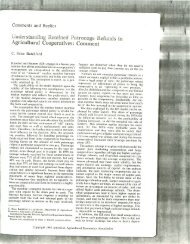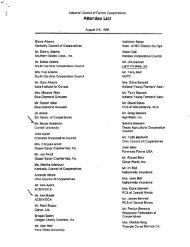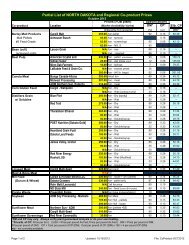Sunflower Production Field Guide - Your "Home Page"
Sunflower Production Field Guide - Your "Home Page"
Sunflower Production Field Guide - Your "Home Page"
Create successful ePaper yourself
Turn your PDF publications into a flip-book with our unique Google optimized e-Paper software.
20<br />
cides such as Poast (sethoxydim) and Clethodim provide<br />
excellent grassy weed control and Assert (imazamethabenz)<br />
will control wild mustard. Clearfi eld<br />
sunfl ower varieties were selected for tolerance of the<br />
herbicide Beyond (imazamox) and will allow postemergence<br />
control of both broadleaf and grassy weeds.<br />
However, ALS (acetolactate synthase)-resistant kochia<br />
is not controlled with this herbicide. For current information<br />
on registered sunfl ower herbicides, contact<br />
your county agent or weed control specialist.<br />
Planting sunfl ower in a no-till production system may<br />
require the addition of residue managers to move<br />
a minimum of crop residue from the seed row so<br />
double-disc openers can place seed properly for seed<br />
to soil contact. Poor placement will delay or prevent<br />
germination, emergence and establishment of the<br />
crop. This, in turn, may lead to weed, insect and harvest<br />
management problems. Single-disc openers and<br />
narrow-point hoe openers have been used successfully<br />
to seed sunfl ower. Minimizing soil disturbance is important.<br />
Soil disturbance can bury weed seed, placing<br />
them in a favorable position to survive, germinate and<br />
establish. Weed seed left on the soil surface is exposed<br />
to weather, insects, birds and fungi and rapidly will<br />
lose viability. Low-disturbance no-till production systems<br />
provide the best opportunity for adequate seed<br />
zone soil water at planting.<br />
No-till and One-pass Seeding<br />
When low-disturbance openers, such as the single-disc<br />
style, are used, seed should be placed at least 2 inches<br />
deep. In undisturbed silt loam soils, the dry/wet inter-<br />
face usually will be found about 1 inch below the soil<br />
surface. In coarse-textured soils, this interface will be<br />
deeper. Planting at or just below this dry/wet interface<br />
will result in poor and/or uneven germination, resulting<br />
in either germinating seed running out of water<br />
and dying before the plant has a chance to establish<br />
or seed lying in dry soil until adequate rainfall is<br />
received.<br />
One-pass seeding operations utilizing high-disturbance<br />
openers (sweeps, hoes and narrow points) can<br />
produce uneven stands under dry conditions. Seeding<br />
depth is more variable with these types of openers,<br />
compared with the single-disc style, and moisture<br />
conditions will be more variable. Long, dry periods<br />
at planting do occur in western North Dakota. Soils<br />
will dry below acceptable levels for germination to<br />
the depth of the disturbed soil in the seedbed. Uneven<br />
germination, emergence, plant stands and plants at<br />
different stages of maturity will occur unless adequate<br />
moisture is received shortly after planting to rewet the<br />
seedbed.<br />
Anhydrous ammonia (Figure 13) sometimes is applied<br />
in one-pass seeding operations with openers specifi -<br />
cally designed for ammonia application at the time of<br />
seeding. If moisture is suffi cient and application rates<br />
do not exceed 50 pounds, little damage to germinating<br />
seed will occur. However, if the seedbed is abnormally<br />
dry and/or the soil does not seal properly between the<br />
anhydrous ammonia band and the seed, damage to<br />
germinating seed will occur.<br />
More recently, no-till row planters with row cleaners<br />
ahead of double-disc openers are equipped with either<br />
■ Figure 13. This one-pass seeding operation is seeding directly into wheat stubble.<br />
Anhydrous ammonia and seed are banded through special openers. Glyphosate and<br />
sulfentrazone were applied three days prior to seeding. (Roger Ashley)







